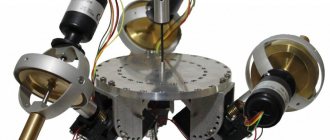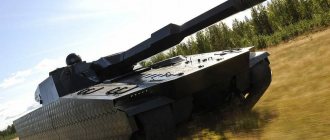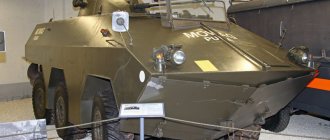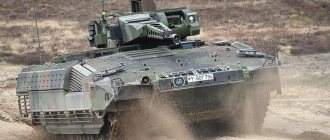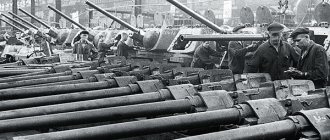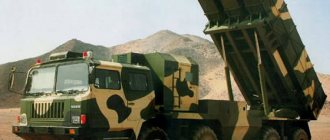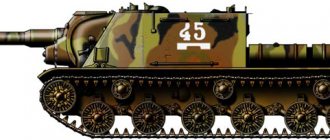BMP CV-90 and its modifications
At the very beginning of the eighties, the Swedish military department began to look for a replacement for the Pbv 302 armored personnel carriers. The armored vehicles, which were good for their time, had been in service for almost twenty years and were no longer modern. Initially, the Swedish Ministry of Defense planned to buy something foreign. For this purpose, several vehicles of a similar weight category were ordered from the UK. However, they differed in purpose. Take the Scorpion, for example - in the English classification it was listed as a light reconnaissance tank. It is unlikely that such a vehicle can be made a successor to the old armored personnel carrier. However, the ordered vehicles were tested at the test site in 1984 and the Swedish military made a number of conclusions. At the same time, there were no large-scale purchases of British equipment: the Swedes nevertheless decided to make a new armored vehicle for the infantry on their own, albeit taking into account foreign developments. This decision was fully consistent with the principle of independence in the defense industry adopted at that time in Sweden. Thus began the history of the family of armored vehicles known under the symbol Strf 90 or CV-90.
The design of the new machine was entrusted to HB Utveckling AB. It is worth noting that based on the results of tests of imported equipment, the Swedish military came to the conclusion that it was necessary to revise their requirements. First of all, instead of an armored personnel carrier, they wanted to get an infantry fighting vehicle with the possibility of creating other types of equipment on its basis. In accordance with the approach adopted in Sweden to the design of armored vehicles, HB Utveckling AB entered into contracts with other companies. So, Bofors was required to make the turret and a full range of weapons, and the Hägglunds company was appointed responsible for the chassis. Thus, HB Utveckling AB was left with only general coordination of the project and the production of a pilot batch of five machines.
The requirements for ensuring the possibility of creating several machines on a single basis affected the development of the chassis. On the one hand, it was necessary to do something new, but on the other, it was necessary to maintain an acceptable cost of the finished machine. Therefore, some of the units were borrowed from equipment that was already being manufactured. The chassis of all vehicles of the Strf 90 family has the same layout and is made according to the classic design for infantry fighting vehicles. The engine and transmission compartment is located in the front of the car on the right. On the left side of the internal volume, accordingly, the driver’s workplace is located. The fighting compartment with a turret installed in it is located in the middle part of the armored vehicle, and the rear part is given over to landing seats.
CV9040 Swedish Army
The power plant of the Strf 90 armored vehicles is based on a 14-cylinder Saab Scania DS14 diesel engine with a power of 550 hp. The transmission is mounted in a single block with the engine. The X300-5 model unit, assembled in Sweden under an English license, is equipped with an automatic planetary gearbox, a differential mechanism with hydrostatic transmission and two final drives. The machine is controlled using a steering wheel, gear lever and pedals. Due to the use of the X300-5 transmission, the vehicles of the Strf 90 family have good maneuvering characteristics and are capable of making turns with an arbitrary radius. With a DS-14 engine, the vehicles of the family have a specific power in the range of 20-25 hp. per ton. At the same time, the Strf 90 armored vehicle can accelerate on the highway to a speed of 70 km/h. In reverse they give out 40-43 km/h.
The chassis and turret of the family's vehicles are protected by multi-layer armor. Its design is interesting: the main body is welded from rolled steel sheets. Then additional composite sheets are mounted on it. Their exact design has not been disclosed. In addition, additional modular armor can be installed on top of the composite modules. Sweden installs German-made AMAP modules on its cars, Norway and Denmark install MEXAS, and the Netherlands install the RUAG system. With additional armor installed, vehicles of the Strf 90 family can withstand a 30-mm projectile from all angles. The frontal projection has a slightly higher level of protection. It should also be noted the angles of the front armor plates. Thanks to their location, while maintaining mass, Swedish engineers were able to slightly improve protection.
Norwegian CV 9030NF1 in Afghanistan, March 2010
The armament of the Strf 90 depends on the specific modification. Thus, the basic CV-9040 infantry fighting vehicle is equipped with a turret with a 40-mm Bofors L70B automatic cannon. It was created on the basis of a towed anti-aircraft gun. Modifications to the gun for installation in the BMP turret are of some interest. In the original anti-aircraft version, shells are fed into the cannon from above, and at the bottom there is a window for ejecting spent cartridges. For use on an infantry fighting vehicle, the cannon was simply turned around its axis. Thanks to this, it was possible to install a shell feeding mechanism under the gun, and bring the cartridge ejection to the top of the turret. Under the breech of the L70V there is a box magazine for 24 rounds. The shells are located in its three compartments, each of which can accommodate eight shells of various types. It is possible to quickly change the type of projectile fed into the gun - for this purpose the magazine is equipped with a hydraulic drive. The automatic gun allows you to fire single, short or long bursts. It is also possible to regulate the rate of fire from 60 to 400 rounds per minute. The length of the queue is limited only by the capacity of the store. Once the latter is used up, the BMP crew must manually charge it. A stock of 216 shells is placed in the fighting compartment: 48 in the mechanized drum and 168 in the stowage. Loading one magazine compartment takes about 20-25 seconds. Several new types of projectiles were developed specifically for the L70B gun: armor-piercing sub-caliber, high-explosive fragmentation with a programmable fuse, general-purpose tracer, etc. The characteristics of the projectiles allow them to hit almost all types of armored vehicles in the world, with the exception of tanks, at a range of up to a kilometer. The gun is aimed horizontally by turning the turret. Vertical aiming, in turn, is carried out using an electro-hydraulic system in the range from -8° to +50°. It is noteworthy that the dimensions of the gun breech and the volume of the fighting compartment allow the barrel to be raised higher, but this possibility was abandoned to improve the ergonomics of the fighting compartment. And it was planned to entrust defense against low-flying enemy aircraft and helicopters to another vehicle of the Strf 90 family.
CV 9035 of the Netherlands Armed Forces. The mounted RoofPRO-P armored modules of the horizontal projections (roof) of the armored hull and the SidePro onboard armored modules are clearly distinguishable.
Additional armament consists of a 7.62 mm machine gun, coaxial with a cannon, with 2000 rounds of ammunition and smoke grenade launchers. In addition, the crews of some CV-9040 infantry fighting vehicles receive RBS-56 Bill anti-missile systems. They can be used either from the tower hatch or from the ground. There is no provision for installing an ATGM on the vehicle itself.
Weapon control is carried out using a single system, which includes a number of units. Thus, the Simag LV-401 laser rangefinder can measure distances within the range of 200-9990 meters with an accuracy of ten meters. The commander has at his disposal Sopelem M371 periscope sights. Data from the rangefinder and sight are fed into the MYBOF ballistic computer. This device semi-automatically provides the necessary corrections to the weapon guidance systems. When calculating them, such parameters as wind speed are taken into account (five options: calm, weak and strong wind on both sides), air temperature (from -50° to +70°) and ammunition (from -35° to +45°). Of particular interest are the fire controls. They are a joystick that controls all the necessary parameters. The tilt of the handle in vertical planes is responsible for the rotation of the turret and the elevation angle of the gun. The angle of the handle affects the speed of turning or lifting. On the top of the joystick - under the thumb - there are weapon selection buttons (cannon or machine gun), and the shot is fired using the trigger under the index finger. Such joysticks are available at the commander's and gunner's workplaces. When these crew members try to simultaneously perform any actions, the automation does not miss the gunner’s commands. The gunner has at his disposal an NTTA periscope sight, a rangefinder and optical periscopes directed in different directions. In addition, the gunner has an additional control knob, with which the laser rangefinder is turned on and off, as well as a number of other actions.
The main armament of the CV-9040 IFV is a powerful 40-mm L/70B cannon, capable of fighting almost any modern armored targets, with the exception of the frontal armor of main battle tanks
In addition to the three-person crew, the CV-9040 BMP can transport eight paratroopers. Landing and disembarkation is carried out through a door in the stern. Additional hatches are made in the roof and bottom of the troop compartment. During the trip, eight soldiers are seated on folding seats of a simple design. The seats themselves are located on the inner sides of the hull. In the early stages of vehicle development, the possibility of installing seats in the middle of the compartment was considered, but this was later abandoned due to a number of disadvantages characteristic of such an arrangement. There are optical devices on the roof and in the door of the troop compartment to monitor the surrounding environment.
The CV-9040 infantry fighting vehicle was the first vehicle of the Strf 90 family. A prototype of the vehicle with a turret equipped with a 40-mm cannon received the index Pbv G. The experimental armored vehicle with the index Pbv L had similar weapons, but a simplified weapons control system. In addition, it was planned to make experimental vehicles with a 25-mm cannon, an anti-aircraft self-propelled gun, etc. As a result of all design work, the following modifications of the armored vehicle were created:
- CV-9040. Infantry fighting vehicle with 40 mm L-70 cannon;
— CV-9030. Export version of the previous vehicle, equipped with a 30 mm Bushmaster II gun;
- CV-9035. Another export version, armed with a 35 mm Bushmaster III cannon;
— CV-90FOV. Reconnaissance vehicle for artillery observers; — CV-90FCV. Command and staff vehicle with a modified troop compartment and additional communications equipment;
— CV-90ARV. Repair and recovery vehicle;
— CV-90AMOS. Self-propelled rapid-fire mortar. Two 120 mm barrels with automatic loaders are placed in a rotating turret;
— CV90120-T The main reason for installing a 120 mm gun on the CV90 was the desire to combine the firepower of a tank with the mobility characteristics of a lighter vehicle. The combat weight of the CV90120-T is about 35 tons, while the tank weighs almost twice as much.
Vehicles of the Strf 90 family were supplied to the Swedish armed forces and were also exported. Sweden received about 350 vehicles of various modifications, Switzerland and the Netherlands have 180-190 units of Strf 90, Finland and Norway ordered a little more than a hundred. Denmark, with its 45 vehicles, brings up the rear on the list of CV-90 users. According to various estimates, armored vehicles of the Swedish Strf 90 family will be relevant for the above countries within the next 15-20 years. After this period, modernization is possible. Judging by the active work in the field of creating new equipment based on the CV-90 chassis, in the future everything will go exactly according to this scenario. Currently, Swedish engineers are experimenting with installing a turret with a 120 mm gun on the CV-90 and continue to improve the AMOS mortar.
Swedish Army CV-9040 vehicles during winter exercises. Firing simulators are attached above the BMP barrel
Based on materials from the sites: https://haggve.se/ https://otvaga2004.narod.ru/ https://army-technology.com/ https://globalsecurity.org/ https://soldf.com/
Story
During the Cold War, Hägglunds began production of a new family of combat vehicles called the Combat Vehicle of the 90s. In 1984, the Swedish Army initiated a request for a unique vehicle with high mobility, air defense and anti-tank capabilities, high performance. survival and protection. A total of five prototypes were developed, which were manufactured in 1988 and tested in trials conducted between 1988 and 1991. CV 90 have now been delivered worldwide
in almost all its variants. . [ 1 ]
Production
Serial production of the CV 90 began in 1993, and by 2000 more than 1,000 reference tanks had been ordered. In November 2000, Finland ordered 57 CV9030
;
[7] for a total of 250 million euros (in 2008 euros), the total value of the armor is 4.42 million euros. [8] In June 2004, Finland placed another order, according to which the number of vehicles in its arsenal is 102 units, [9] and under this contract the amount to be paid for each armored personnel carrier was 2.92 million euros (in euros in 2008).[9] In December 2005, Denmark ordered 45 CV9035
at a cost of 188 million euros with a per unit payment of 4.18 million euros.
[10] The Kingdom of Holland requested 184 vehicles in combat configuration and 8 in troop training configuration under the number CV9035
, each of these vehicles cost 3901 million euros; the total amount paid was 749 million euros. [ eleven ]
Users
Current
- SwedenSweden
Primary user and builder, with 509 HP 90
in service, including 42
CV9040C
with added armor. [ 22 ] [ ] [ ]
- Denmark Denmark
45 CV 90
, in version
CV9035DK
. [25]
- Estonia Estonia
44 CV9035NL Bought in the Netherlands in December 2014. Now called CV9035EE. The first delivery took place in 2016. [44] [45] That same year, Estonia reached an agreement with Norway to purchase 35 additional surplus MK Is. [46] Supplies from the Netherlands ended on April 1, 2022. [
- Finland Finland
102 CV 90
, in version
CV9030FIN
(57 in the first order, 45 in the second order) [26] []
- Netherlands Netherlands
193 CV 90
in the
CV9035NL
(initial order was for 184 vehicles [28] increased to 193 vehicles [29]. Deliveries will be completed before the end of 2011).
- NorwayNorway
104 CV 90s
in the
CV9030N
, of which 17 were updated and/or improved to include air conditioning in the troop compartment, additional armor and a rear view camera and renamed
CV9030NF1
. [ thirty ] [ ]
- Swiss Swiss
186 CV 90
or
CV9030CH
[ 31 ]
Only in tests
- Canada Canada
1 CV9035 Mark III, testing only. [32]
- United Kingdom United Kingdom In the end, ASCOD SV was chosen.
- Poland Poland
Developed by VCI Anders.
Gallery
- Swedish CV 90
(CV9040A
/ Strf 9040A
). - Swedish CV 90
(CV9040B
/ Strf 9040B
). - Finnish CV 90
( CV9030FIN
)
. - Norwegian CV 90
(CV9030N
)
. - CV 90
with a 120 mm cannon.
( CV90120-T
/ anti-tank variant). - Dutch CV 90
(CV9035NL
)
. - CV 90
in anti-aircraft vehicle configuration (CV90AAV
/Lvkv 90
). - Swiss CV 90
(CV9030CH
/SPz 2000
).
external reference
- Wikimedia Commons has a multimedia category on CV 90
. - Combat vehicle 90 in army technology
- Information about Combat Vehicle 90 at BAE Systems Hägglunds
- SoldF.com - CV9040 (in Swedish)
- Armada International 6/97-52 Information from the Norwegian VCI about tests and changes found in the CV9030, at your service (in English)
- CV9035 MkIII in Danish service
| Control of authorities |
|
- Data: Q659630
- Multimedia: Hägglunds Combat Vehicle 90

